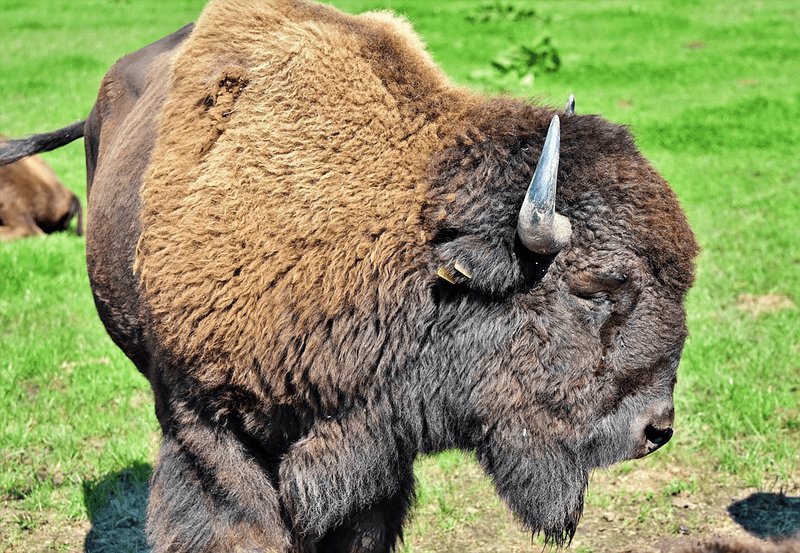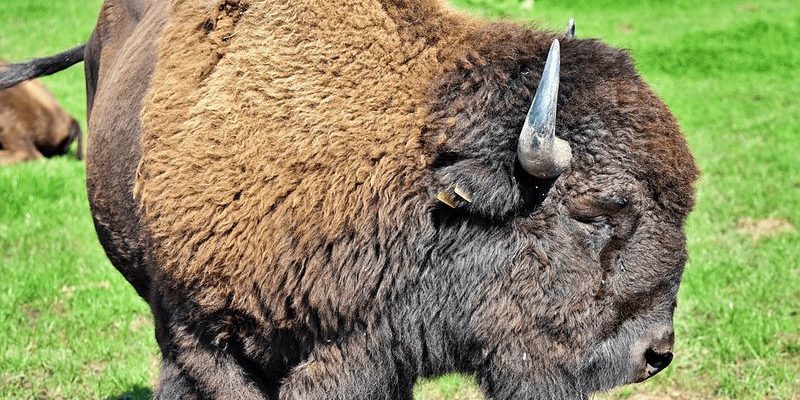
In this article, we’ll explore 10 animals similar to the European bison. Along the way, I’ll break down how to tell them apart, emphasizing key features that make each species unique. Whether you’re a wildlife enthusiast or just curious about the natural world, you’ll find this information useful and interesting. Let’s dive in!
1. American Bison
The American bison is probably the closest relative to the European bison. Often called the buffalo, it’s known for its massive size and shaggy fur. While they share many traits, here’s how you can spot the differences:
– Habitat: American bison prefer the grasslands of North America, while European bisons tend to wander through forests and open areas in Europe.
– Hump: The American bison has a more pronounced hump on its shoulders, which can make it look quite different from its European cousin.
– Color: Generally, American bison have a darker, more consistent coloring compared to the light brown hues of the European bison.
If you ever get a chance to see them side by side, their size and color differences are quite striking!
2. Yak
Yaks are fascinating animals that thrive in the cold, mountainous regions of Central Asia. They have long hair and a sturdy build, much like bison. But how do you tell them apart?
– Environment: While both animals are strong, yaks are specially adapted to cold, high-altitude environments, whereas European bison prefer milder climates.
– Tail: Yaks have long, bushy tails that resemble a lion’s mane, while bison have a much shorter and less hairy tail.
– Horns: Yaks exhibit long, curved horns, which are quite different from the shorter, more robust horns of the European bison.
Next time you’re thinking about rugged terrain, imagine a yak gracefully navigating it!
3. Water Buffalo
Water buffaloes are well-known for their ability to thrive in wetland areas. They also share some characteristics with the European bison but come with their own unique traits:
– Body Shape: Water buffaloes have a more svelte and less muscular body compared to the stockier build of the European bison.
– Horns: Their horns are often larger and curve outward, resembling a crescent moon, while bison’s horns are shorter and curve more inward.
– Behavior: Water buffaloes are usually found in herds that are often more social and family-oriented than the sometimes solitary European bison.
Imagine a water buffalo lounging in a muddy pond—it’s a different vibe from the dense forests of the wisent!
4. Highland Cattle
With their shaggy coats and formidable horns, Highland cattle can look quite similar to the European bison at first glance. However, they are different animals with distinct characteristics:
– Size: Highland cattle are generally smaller than European bison, standing lower to the ground despite their long hair.
– Coat Color: They can vary in color from brown to black, while European bison primarily have a light brown tone.
– Horn Shape: The horns of Highland cattle are long and often extend straight out to the sides, while the bison’s horns curl more.
These cattle might remind you of a fluffy friend in the pasture, but they don’t have the same impressive size as the bison.
5. Cape Buffalo
Cape buffaloes, native to Africa, are another fascinating animal that bears resemblance to the European bison. But there are key differences:
– Environment: Cape buffalo prefer savannas and grasslands of Africa, in contrast to the woodland habitats of the European bison.
– Horns: The horns of a cape buffalo are massive and curved, forming a distinct “boss” shape, while the European bison’s horns are smaller and more defined.
– Temperament: Cape buffaloes are often more aggressive and territorial compared to the generally calmer European wisent.
Watching these giants graze in the African grasslands is quite a sight—just be sure to keep a safe distance!
6. Gaur (Indian Bison)
The gaur, or Indian bison, is a large bovine native to South Asia and can be mistaken for the European bison because of their size. However, they have some unique features:
– Size Difference: Gaur are typically larger, often weighing up to 3,000 pounds, which can overshadow the European bison.
– Coloration: They often have a dark brown to black coat, with lighter shades on their legs, creating a striking contrast with the wisent’s softer tones.
– Posture: Gaur have long legs and a less stocky frame compared to the European bison, giving them a more graceful appearance.
If you ever visit Asia, spotting a gaur in the wild can feel like witnessing a living legend!
7. Kankrej
The Kankrej is a breed of cattle from India, known for its endurance and strength. Here’s how you can tell it apart from the European bison:
– Body Structure: Kankrej cattle have a leaner body and are generally much smaller than European bison, which boast more muscle mass.
– Horns: They have long, straight horns that are quite different from the curved horns of the bison.
– Coloration: Kankrej cattle can come in various shades, but they usually feature more muted colors compared to the rich browns of European bison.
You might not see this breed in the wild, but they’re an important part of agricultural life in India.
8. Zebu
Zebus are another type of cattle, recognized by their distinctive hump over the shoulders. They have a few notable differences when compared to the European bison:
– Hump: This prominent hump is a key feature of zebus, unlike the bison, which lacks this characteristic.
– Size: Zebus are generally smaller and lighter than European bison, making them easier to manage for farming and herding.
– Temperature Adaptation: Zebus are well-adapted to hot climates, while European bison thrive in temperate regions.
If you’re ever in a region where zebus roam, their unique look can be quite captivating!
9. Bos taurus (Domestic Cattle)
Domestic cattle are probably the most familiar bovine relatives. They share several features with the European bison, but there are also some key differences:
– Domestication: Domestic cattle are bred by humans for agricultural purposes, while European bison are wild animals.
– Physical Features: Domestic cattle vary widely in size and shape, often smaller than the robust bison.
– Coat and Color: The variety in coat colors and markings in domestic cattle can be seen on farms, unlike the more uniform look of the wisent.
Seeing a herd of domestic cattle can be comforting and familiar, akin to catching up with old friends.
10. Bongo
Finally, the bongo is a striking antelope found in the rainforests of Central and West Africa. They may not look like bison at first, but here’s why they’re worth mentioning:
– Coloration: Bongos have a vibrant reddish-brown coat with white stripes, which stands in stark contrast to the more muted colors of the European bison.
– Size: They are generally smaller, with a more slender frame, while bison exude that massive presence.
– Horns: Bongos possess long, spiral horns that curve outward, which differ from the broad and short horns of the bison.
These elegant creatures might be hard to spot in the dense forest, but their beauty is unforgettable if you do!
In conclusion, understanding these 10 animals similar to the European bison can enrich your appreciation of wildlife. Each species, from the American bison to the bongo, contributes its own charm and uniqueness. Next time you think about the majestic wisent, remember there’s a whole world of fascinating relatives out there—each with its quirks and traits. Whether you’re a wildlife lover or just curious, I hope you found this exploration enjoyable and enlightening!

